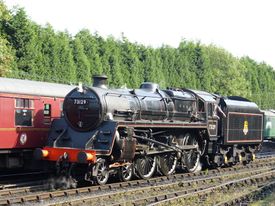BR Standard Class 5 73129
It is a British Railways Standard Class 5MT 4-6-0 locomotive, one of the twelve standard classes of locomotives designed for BR by RA Riddles in the 1950s. The 5MT was essentially a development of the LMS Stanier 'Black 5'. A total of 172 were built between 1951 and 1957, of which 30 were equipped with Caprotti valve gear and poppet valves instead of the more normal Walschaerts valve gear.
Five Standard 5MTs have survived into preservation of which 73129 is the only Caprotti fitted example. 71000 Duke of Gloucester is the other preserved BR locomotive to be so fitted[1].
Contents
Service
73129 was built at Derby and was allocated new to Shrewsbury during August 1956. In 1958 it was re-allocated to Patricroft in Eccles, Greater Manchester, from where it was withdrawn in December 1967[2].
Preservation
73129 arrived at Barry in February 1968. It was chosen for preservation by Derby Council as an example of a Derby-built locomotive, and was moved by rail from Barry to Derby in January 1973. A move to its current home, the Midland Railway Centre at Butterley, followed in 1975.[3]
Restoration began in 1994, and the locomotive was steamed for the first time in May 2005. 73129 is owned by Derby City Museums and Art Gallery and is on long term lease to the Midland Railway Trust[4][3].
73129 at the SVR
73129 was hired by the SVR in summer 2014, as the SVR fleet was 'one short' at the time. It entered service in early June and quickly became popular with footplate crews and visitors alike. The combination of Caprotti valve gear and roller bearings was found to produce little rolling resistance, while the locomotive was noted to be very ‘vocal’ when climbing gradients. The hire period included an appearance in the Autumn Steam Gala and ended in September 2014 with a total of 3,550 miles recorded[5].
See also
References
- ↑ Wikipedia
- ↑ BR Database (Retrieved 11 April 2018)
- ↑ 3.0 3.1 Beckett and Hardingham (2010)
- ↑ Midland Railway Centre Class 5MT (retrieved 11 April 2018)
- ↑ SVR News 187/188

